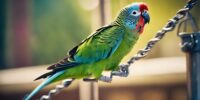How to Recognize the Nutritional Needs of Parrots Based on Their Native Habitat
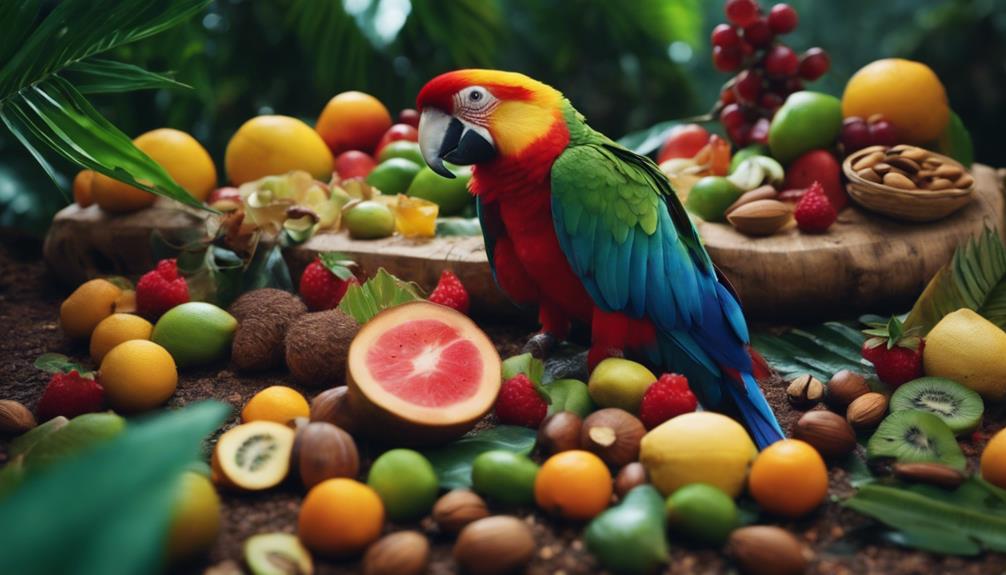
Recognizing Parrots' Nutritional Needs Based on Habitat:
A Guide to Tailoring Diets for Optimal Health and Well-being.
This comprehensive guide explores the various nutritional requirements of parrots based on their natural habitats. It provides valuable insights into creating diets that promote optimal health and well-being for these intelligent birds.
By understanding the specific dietary needs of parrots in different environments, bird owners can ensure that their feathered friends receive the essential nutrients they need to thrive.
Parrot Diets in Tropical Rainforests
In tropical rainforests, parrots primarily consume a diverse array of fruits, nuts, seeds, and vegetation to meet their nutritional needs. Rainforest foraging is a crucial aspect of a parrot's diet, as these birds have evolved to efficiently extract nutrients from the abundance of plant species available in this habitat. The tropical fruit consumption of parrots provides them with essential vitamins, minerals, and antioxidants necessary for their overall health and well-being. By feeding on a variety of fruits, such as figs, palm nuts, and berries, parrots ensure they obtain a balanced diet that supports their energy requirements and sustains their vibrant plumage.
Parrots in tropical rainforests exhibit specialized foraging behaviors, such as using their strong beaks to crack open hard shells and extract seeds or nuts. This adaptation allows them to access hidden food sources and utilize their unique anatomical features for efficient nutrient extraction. Their diet also includes a mix of leaves, flowers, and buds, providing additional nutrients and dietary fiber essential for digestive health. Understanding the dietary habits of parrots in tropical rainforests is crucial for designing appropriate conservation efforts and ensuring the well-being of these colorful avian species.
Nutritional Adaptations in Arid Regions

Parrots inhabiting arid regions have evolved to adapt to the challenges posed by the harsh desert climate. These adaptations include specialized physiological mechanisms to conserve water and the ability to extract nutrients from desert plants unique to their environment.
Arid Climate Impact
Adapting to arid climates, parrots in these regions have developed specialized nutritional strategies to thrive in their environment. To combat dehydration risks and ensure optimal health, these birds have evolved specific dietary adjustments.
In arid regions, water conservation is crucial, leading parrots to rely on moisture-rich foods to supplement their hydration needs. Additionally, they've adapted to obtain essential nutrients from unconventional sources to meet their dietary requirements. This includes seeking out plants and fruits with high water content and extracting moisture from succulents.
Desert Plant Consumption
Having evolved to thrive in arid climates, parrots in these regions demonstrate specialized nutritional adaptations, particularly in their consumption of desert plants to meet their dietary requirements. Desert plant foraging is crucial for these parrots as it provides essential nutrients such as water consumption, which is limited in arid environments.
Additionally, the seed diversity found in desert plants offers a variety of nutrients necessary for their survival. Parrots in arid regions have adapted to efficiently extract minerals from these plants, aiding in their overall health. Their ability to utilize the resources available in the desert showcases their remarkable adaptation to challenging environments, ensuring they meet their nutritional needs despite the harsh conditions.
Coastal Parrots and Their Diet
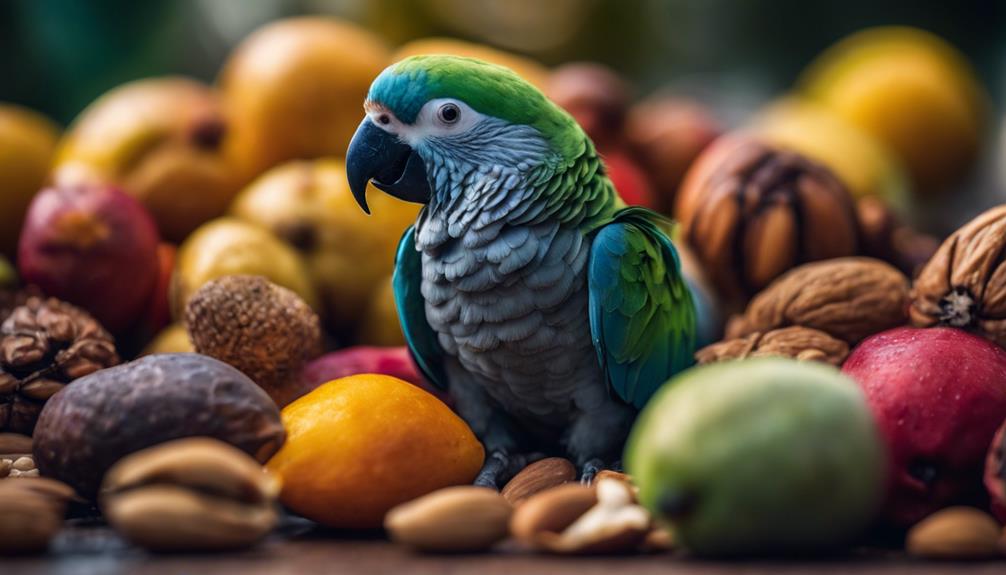
In their coastal habitats, these avian species demonstrate a specialized dietary adaptation to thrive in marine-influenced environments. Coastal parrots have evolved to rely on specific food sources to meet their nutritional needs. Here are some key aspects of their diet:
- Beachside Foraging: Coastal parrots are adept at foraging along the shorelines for a variety of coastal fruits rich in essential vitamins and minerals. They've developed unique foraging techniques to extract nutrients from these fruits.
- Seaside Seafood: These parrots have incorporated a significant amount of seafood into their diet, sourcing protein and omega-3 fatty acids from various marine organisms. Their consumption of saltwater sources contributes to their mineral intake and overall health.
- Adaptation to Saltwater: Coastal parrots have developed mechanisms to process and eliminate excess salt intake from their diet, allowing them to thrive in environments where freshwater sources may be limited.
Understanding the dietary preferences and adaptations of coastal parrots is crucial for providing them with appropriate nutrition in captivity or conservation efforts.
Mountain Parrots' Unique Nutritional Needs

Mountain parrots exhibit specialized dietary requirements influenced by their high-altitude environment, necessitating a closer examination of their nutritional needs. These parrots, found in alpine regions, have adapted to survive in harsh conditions by developing unique dietary preferences and specialized requirements. Their diet often consists of a variety of alpine foraging plants, seeds, and fruits that are specific to their mountain habitats. Due to the scarcity of food sources at higher altitudes, mountain parrots have evolved to efficiently extract nutrients from the limited resources available to them.
High altitude nutrition plays a crucial role in the health and well-being of mountain parrots. These birds require specific nutrients to thrive in their challenging environment, such as antioxidants to combat oxidative stress caused by high altitudes. Understanding the nutritional needs of mountain parrots is essential for ensuring their optimal health and longevity in their natural habitat. By providing a diet that aligns with their specialized requirements, caregivers can support the overall well-being of these remarkable birds.
Grassland Parrots: Diet Insights
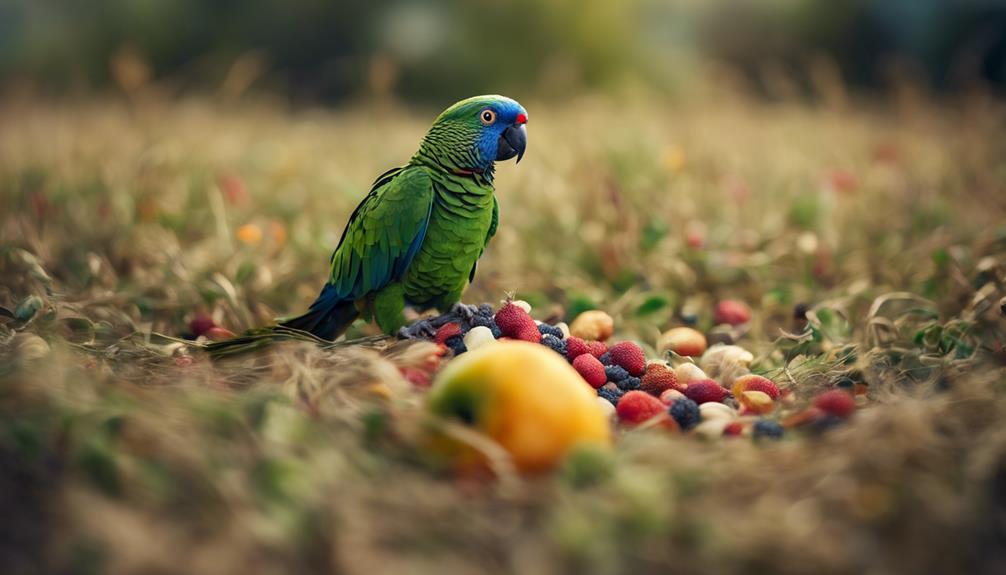
Grassland parrots exhibit dietary preferences tailored to their open habitat, reflecting adaptations to the vast plains they inhabit. In these environments, seed diversity plays a crucial role in ensuring nutritional balance for these avian species. Understanding the foraging behavior and food availability for grassland parrots is essential to provide them with a diet that meets their specific needs.
Key Insights:
- Seed Diversity: Grassland parrots rely heavily on a variety of seeds to meet their nutritional requirements. Their diet includes a mix of grass seeds, herbaceous plant seeds, and occasionally tree seeds to ensure they receive the necessary nutrients for their well-being.
- Nutritional Balance: Foraging behavior is closely linked to food availability in the open grasslands. Parrots in these habitats have developed specialized feeding techniques and beak shapes to efficiently extract seeds, ensuring they maintain a balanced diet rich in proteins, fats, and essential vitamins.
- Food Availability: The seasonal variations in food sources impact the diet of grassland parrots, influencing their foraging patterns and nutritional intake. Understanding these fluctuations is crucial for providing optimal nutrition to these birds in captivity.
Understanding Island Parrot Nutrition
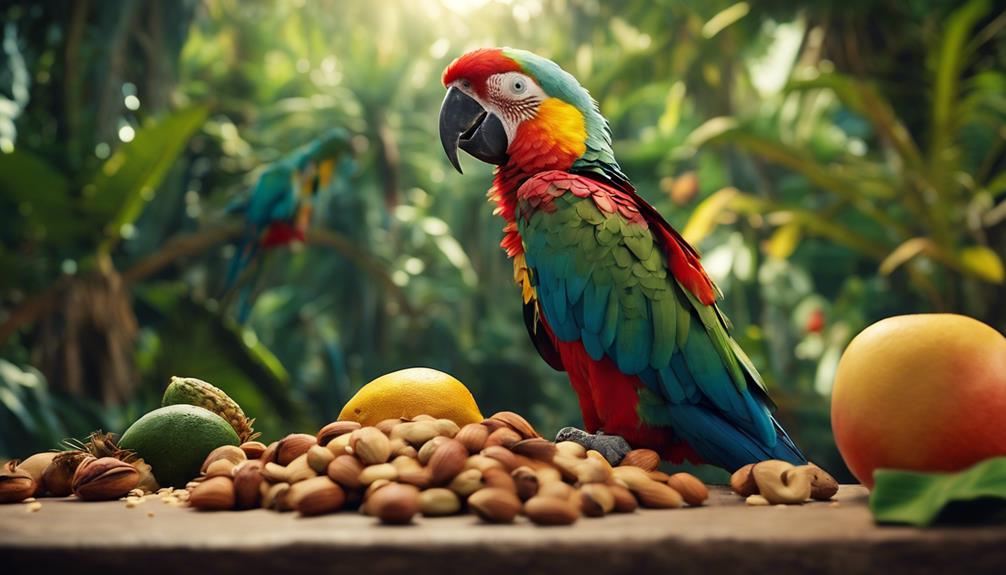
Understanding the nutritional requirements of island parrots involves analyzing their unique dietary preferences and adaptations to their specific habitat. Coastal parrot nutrition plays a crucial role in the diet of island parrots, as they often rely on a variety of coastal vegetation, fruits, nuts, and occasional seafood for their sustenance. Their foraging behavior is highly influenced by the availability of these coastal resources, leading them to develop specialized feeding strategies to extract maximum nutrition from their environment. Island parrot diet exhibits seasonal variations, with certain fruits and plants being more abundant during specific times of the year. This variation necessitates the parrots to adapt their feeding habits accordingly to ensure they meet their nutritional needs throughout the year.
| Coastal Parrot Nutrition | Island Parrot Diet |
|---|---|
| Seaweed | Fruits |
| Sea grapes | Nuts |
| Shellfish | Berries |
| Mangrove leaves | Insects |
Urban Environments and Parrot Diet Variations

Island parrots' dietary adaptations extend to urban environments, where they demonstrate variations in their diet influenced by the availability of human-provided food sources. City-dwelling parrots face unique dietary challenges in urban settings, requiring them to adapt their feeding strategies to thrive.
- Urban Foraging: City-dwelling parrots often engage in urban foraging to supplement their diet. They scavenge for food in parks, gardens, and even trash bins to meet their nutritional needs.
- Dietary Challenges: Urban environments present dietary challenges for parrots, as they may encounter processed foods high in sugar, salt, and unhealthy fats. These items can lead to nutritional imbalances and health issues if consumed regularly.
- Feeding Strategies: To address these challenges, city-dwelling parrots may need to rely on the guidance of knowledgeable caretakers to provide a balanced diet. This may include a combination of commercial parrot pellets, fresh fruits and vegetables, and occasional treats to ensure optimal nutrition and overall well-being.
Frequently Asked Questions
How Do Parrots in Urban Environments Adapt Their Diets to the Lack of Natural Food Sources?
In urban environments, parrots adapt their diets by utilizing various foraging strategies to compensate for the lack of natural food sources. They might scavenge for human food scraps, raid bird feeders, or consume a wider range of available plants and fruits.
Are There Any Specific Nutritional Challenges Faced by Parrots Living on Islands?
Amidst the lush confines of islands, parrots encounter distinct dietary trials. Coping with limited resources and unique flora, island parrots must adapt, evolving specialized nutritional needs to thrive in their isolated ecosystems.
Do Mountain Parrots Have Specific Dietary Requirements That Differ From Parrots in Other Habitats?
Mountain parrots, due to altitude adaptations, may have unique nutrient requirements compared to parrots in other habitats. Their diet could reflect these needs, potentially including specific foods to meet their elevated metabolic demands and environmental challenges.
How Do Coastal Parrots Obtain Essential Nutrients From Their Diet Given Their Proximity to the Ocean?
Coastal parrots, through marine foraging, source essential nutrients from their diet. They exhibit remarkable adaptability in nutrient absorption, enabling efficient mineral intake from oceanic elements. This unique feeding behavior highlights their specialized dietary strategies for survival and health.
Are There Any Common Nutritional Deficiencies Seen in Grassland Parrots Due to Their Specific Habitat?
Grassland parrots may face common nutrient deficiencies due to their specific habitat. Their diet often lacks certain essential nutrients found in other environments. Foraging strategies play a crucial role in how grassland parrots obtain necessary nutrients.



